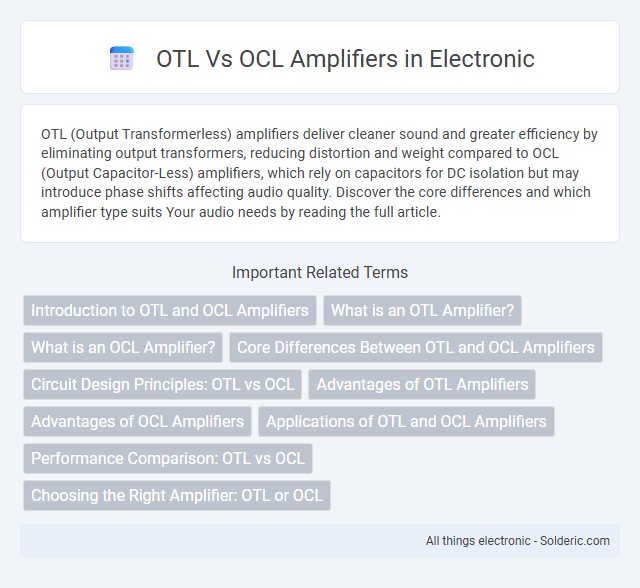OTL (Output Transformerless) amplifiers deliver cleaner sound and greater efficiency by eliminating output transformers, reducing distortion and weight compared to OCL (Output Capacitor-Less) amplifiers, which rely on capacitors for DC isolation but may introduce phase shifts affecting audio quality. Discover the core differences and which amplifier type suits Your audio needs by reading the full article.
Comparison Table
| Feature | OTL Amplifiers (Output Transformer-Less) | OCL Amplifiers (Output Capacitor-Less) |
|---|---|---|
| Transformer | No output transformer needed | No output transformer needed |
| Output Coupling | Direct coupling, no output capacitor | Direct coupling, no output capacitor |
| Frequency Response | Wide frequency response due to absence of transformer | Wide frequency response, extends to low frequencies |
| Distortion | Typically low distortion; transformer saturation avoided | Low distortion; no capacitive coupling harmonics |
| Power Efficiency | High efficiency as transformers can cause losses | High efficiency; no transformer or capacitor power loss |
| Complexity | More complex transistor arrangement for biasing and protection | Simpler design but requires careful DC offset management |
| DC Offset & Speaker Protection | Requires circuitry to block DC to speaker | Typically includes DC servo or protection to prevent speaker damage |
| Application | High-fidelity audio amplifiers | Hi-fi and portable audio amplifiers |
| Cost | Lower cost without transformers | Lower cost as capacitors eliminated, but slight increase for protection circuitry |
Introduction to OTL and OCL Amplifiers
OTL (Output Transformer-Less) and OCL (Output Capacitor-Less) amplifiers eliminate bulky output transformers and large coupling capacitors, offering improved audio clarity and frequency response. OTL amplifiers directly drive speakers without transformers, reducing signal distortion and enhancing efficiency. OCL amplifiers remove output capacitors, enabling better low-frequency performance and greater power delivery to your speakers.
What is an OTL Amplifier?
An OTL (Output Transformer-Less) amplifier is a type of audio amplifier designed to drive speakers directly without the use of output transformers, resulting in reduced distortion and improved frequency response. It typically employs complementary transistor pairs in its output stage, enabling efficient power delivery and better linearity compared to transformer-coupled amplifiers like OCL (Output Capacitor-Less) models. OTL amplifiers are favored for their compact design, lower weight, and enhanced audio fidelity in high-performance sound systems.
What is an OCL Amplifier?
An OCL amplifier (Output Capacitor-Less) is a type of audio amplifier that directly couples the output signal to the load without using a large coupling capacitor, ensuring better low-frequency response and reduced distortion. Unlike OTL amplifiers (Output Transformer-Less), OCL designs avoid bulky transformers and capacitors, making your audio system more compact and efficient. OCL amplifiers are ideal for high-fidelity sound applications where clean, linear output is crucial.
Core Differences Between OTL and OCL Amplifiers
OTL (Output Transformer-Less) amplifiers eliminate the bulky output transformer found in OCL (Output Transformer Coupled) amplifiers, resulting in improved frequency response and reduced distortion. OCL amplifiers rely on transformers to match impedance and isolate the output stage, which can introduce phase shifts and limit bandwidth. The core difference lies in the signal path design: OTL designs enable direct coupling to the load, enhancing efficiency and audio clarity, while OCL circuits depend on transformer coupling for voltage and current matching.
Circuit Design Principles: OTL vs OCL
OTL (Output Transformer-Less) amplifiers utilize a direct-coupled output stage that eliminates the need for an output transformer, resulting in improved frequency response and reduced distortion. OCL (Output Capacitor-Less) amplifiers employ capacitor-free coupling by utilizing a DC bias point that allows the audio signal to pass without low-frequency roll-off, enhancing bass reproduction and reducing phase shifts. Understanding these circuit design principles helps you choose an amplifier that best suits your audio system's performance requirements.
Advantages of OTL Amplifiers
OTL (Output Transformer-Less) amplifiers provide superior audio fidelity by eliminating the distortion and frequency response limitations caused by output transformers in OCL (Output Capacitor-Less) amplifiers. They offer enhanced efficiency and reduced weight, making them ideal for high-performance and portable audio systems. OTL designs also simplify maintenance and improve heat dissipation, resulting in more reliable and durable amplification.
Advantages of OCL Amplifiers
OCL (Output Capacitor-Less) amplifiers offer superior audio fidelity by eliminating bulky output coupling capacitors, which can introduce phase shifts and frequency response anomalies. These amplifiers provide improved low-frequency performance and enhanced transient response, ensuring clearer and more accurate sound reproduction. Your audio system benefits from increased efficiency and reliability due to reduced component stress and simplified circuit design.
Applications of OTL and OCL Amplifiers
OTL (Output Transformer-Less) amplifiers are widely used in high-fidelity audio systems, home theater setups, and professional sound equipment due to their low distortion, high efficiency, and reduced weight compared to transformer-based designs. OCL (Output Capacitor-Less) amplifiers find applications in compact audio devices, portable speakers, and automotive audio systems, offering improved frequency response and eliminating the need for bulky coupling capacitors. Both amplifier types enhance sound quality in consumer electronics, with OTL preferred for high-power demands and OCL suited for space-constrained configurations.
Performance Comparison: OTL vs OCL
OTL (Output Transformer-Less) amplifiers deliver higher bandwidth and lower distortion compared to OCL (Output Capacitor-Less) amplifiers, enhancing audio fidelity in high-performance systems. OCL amplifiers typically feature simpler designs with fewer components, which can reduce cost and improve reliability but may compromise low-frequency response and introduce phase shifts. Your choice between OTL and OCL amplifiers should consider the desired audio quality and system requirements, as OTL models are often favored for superior sound clarity and dynamic range.
Choosing the Right Amplifier: OTL or OCL
Choosing the right amplifier between OTL (Output Transformer-Less) and OCL (Output Capacitor-Less) depends on factors like sound quality, design complexity, and application needs. OTL amplifiers offer better linearity and reduced harmonic distortion, making them ideal for high-fidelity audio systems, while OCL amplifiers provide simpler circuitry and improved low-frequency response thanks to the absence of coupling capacitors. Evaluating power output requirements, speaker impedance compatibility, and thermal management assists in selecting the optimal amplifier type for specific audio performance goals.
OTL vs OCL amplifiers Infographic

 solderic.com
solderic.com